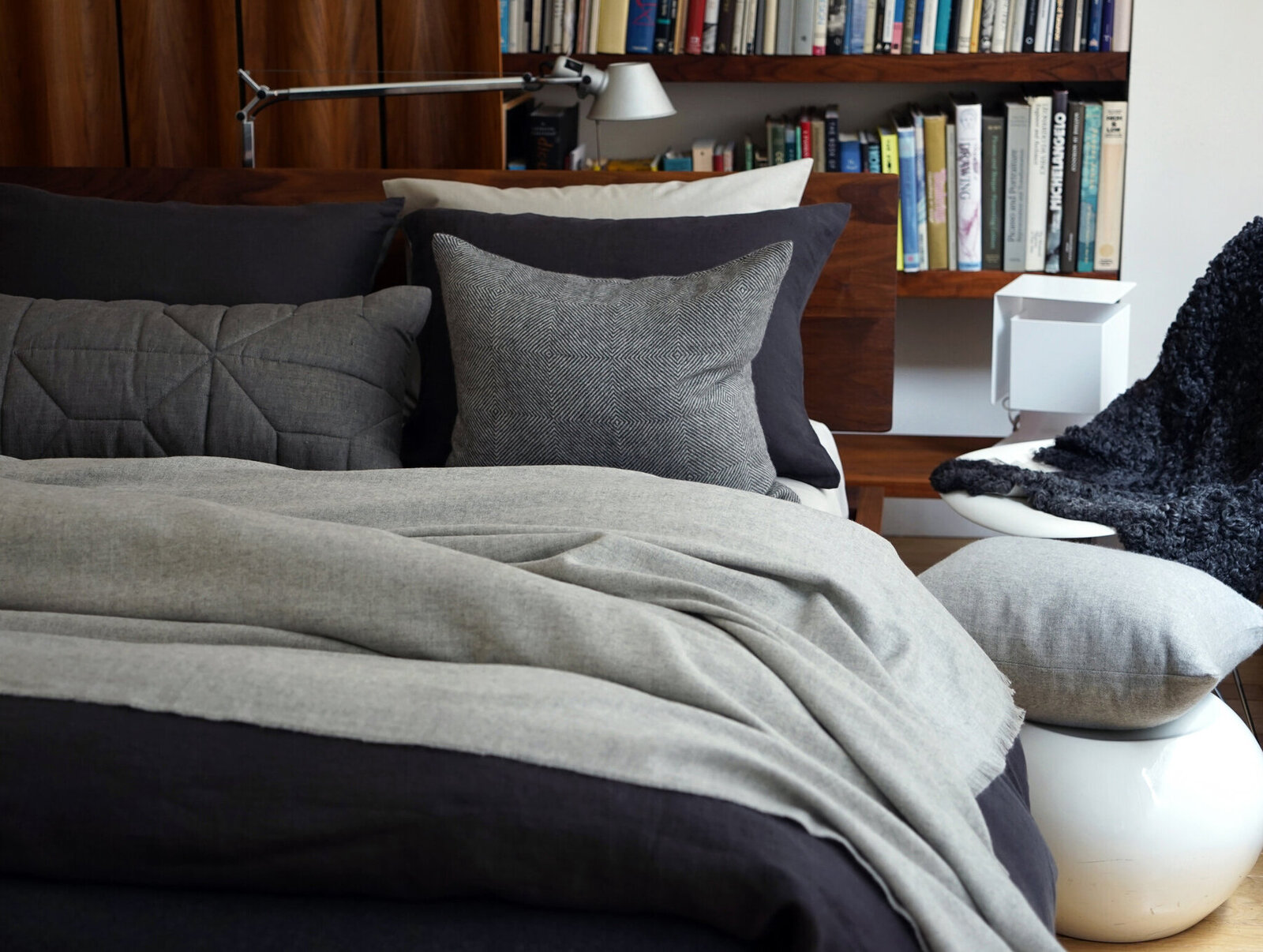Home>Interior Design>Bedding Mistakes: How To Avoid These 7 Bedding Blunders


Interior Design
Bedding Mistakes: How To Avoid These 7 Bedding Blunders
Modified: August 28, 2024
Avoid costly bedding mistakes and create a stunning interior design with these essential tips! Learn how to avoid 7 common bedding blunders.
(Many of the links in this article redirect to a specific reviewed product. Your purchase of these products through affiliate links helps to generate commission for Storables.com, at no extra cost. Learn more)
Introduction
When it comes to creating a comfortable and inviting bedroom, one crucial element often overlooked is bedding. Your choice of bedding can greatly impact your sleep quality and overall comfort. However, many people unknowingly make a variety of bedding mistakes that can hinder their ability to fully enjoy their sleep sanctuary.
In this article, we will highlight seven common bedding blunders and provide you with expert advice on how to avoid them. By making simple adjustments to your bedding choices, you can transform your bedroom into a cozy and serene retreat.
So, let’s dive in and discover how to steer clear of these common bedding mistakes and create the perfect sleep environment.
Key Takeaways:
- Choose the right size bedding to avoid discomfort and frustration caused by ill-fitting sheets and comforters. Properly fitting bedding enhances the look of your bedroom and contributes to a more comfortable sleep environment.
- Pay attention to thread count and fabric quality when selecting bedding. Opt for materials that are comfortable, breathable, and durable to ensure a cozy and restful sleep experience.
Mistake #1: Choosing the Wrong Size
One of the most fundamental bedding mistakes is choosing the wrong size for your bed. Whether it’s a fitted sheet that’s too small or a comforter that barely covers the mattress, an ill-fitting bedding can lead to discomfort and frustration.
When selecting bedding, be sure to measure your mattress accurately to determine the correct size. A standard twin bed requires twin-sized bedding, while a queen-sized bed needs queen-sized bedding, and so on. It’s important to note that mattresses can vary in dimensions, so it’s always best to measure rather than assume.
Choosing the right size is not just about aesthetics; it also affects the functionality of your bedding. A fitted sheet that is too small may constantly slip off, leaving you struggling to keep it in place throughout the night. On the other hand, an oversized comforter can hang over the edge of the bed, causing it to bunch up or drag on the floor.
Make sure to reference the dimensions of your mattress when shopping for bedding, and double-check the packaging to ensure the correct size is indicated. Investing in bedding that fits properly will not only enhance the overall look of your bedroom but also contribute to a more comfortable and restful sleep environment.
Mistake #2: Neglecting Thread Count
Thread count is a term that often gets thrown around when discussing bedding, but many people underestimate its importance. The thread count refers to the number of threads per square inch of fabric, and it can greatly impact the quality and feel of your sheets.
Some people assume that a higher thread count automatically means better quality, but that’s not always the case. While a higher thread count can indicate a denser weave and smoother texture, the quality of the fabric is equally important.
When choosing your bedding, consider both the thread count and the type of fabric. Cotton sheets with a thread count between 200 and 400 can provide a comfortable and breathable sleep experience. Egyptian cotton and Pima cotton are renowned for their softness and durability, making them popular choices for bedding.
However, it’s important to note that thread count alone doesn’t guarantee luxury. Some manufacturers artificially inflate thread counts by using multi-ply yarns or twisting multiple strands together. This can result in a less comfortable and less durable fabric.
Ultimately, it’s best to strike a balance between thread count and fabric quality. Consider your personal preferences for softness and breathability, and opt for bedding that provides the right combination of comfort and durability.
Mistake #3: Ignoring Fabric Quality
When it comes to bedding, the quality of the fabric is just as important as the thread count. The fabric you choose can affect the feel, breathability, and durability of your bedding.
One common mistake is overlooking the fabric quality in favor of aesthetics or price. While it may be tempting to choose bedding based solely on its appearance, investing in high-quality fabrics will ensure long-lasting comfort.
There are various types of fabrics commonly used for bedding, including cotton, linen, silk, and synthetic materials. Each fabric has unique properties that can influence your sleep experience.
Cotton is a popular choice for bedding as it is breathable, soft, and easy to care for. Egyptian cotton and Pima cotton are known for their exceptional quality and luxurious feel. Linen offers excellent breathability and is ideal for warmer climates. Silk is a luxurious and hypoallergenic choice, providing a smooth and lustrous surface. Synthetic materials like polyester can be more affordable but may lack the breathability and natural feel of cotton or linen.
When selecting bedding, pay attention to the fabric content listed on the product label. Opt for natural and high-quality materials that suit your preferences and sleep needs. It’s also worth considering any specific allergies or sensitivities that you may have.
Investing in bedding made from quality fabrics will not only enhance your sleep comfort but also ensure that your sheets and blankets withstand the test of time. Prioritizing fabric quality is a decision that pays off in the long run, resulting in a better sleep experience and increased satisfaction with your bedding.
Mistake #4: Not Considering Allergies
Allergies can significantly impact your sleeping patterns and overall well-being. However, many people overlook the potential allergenic properties of their bedding. Ignoring allergies can lead to uncomfortable nights and disrupted sleep.
One common bedding mistake is not considering allergies when selecting materials. Certain fabrics and fillings can trigger allergies, causing symptoms like sneezing, itching, or difficulty breathing. Dust mites, pet dander, and mold can also accumulate in bedding over time, exacerbating allergy symptoms.
To create an allergy-friendly sleep environment, opt for hypoallergenic bedding materials. Look for fabrics that are naturally resistant to allergens, such as tightly woven cotton or silk. These materials are less likely to trap dust, pet dander, or mold, making them a suitable choice for allergy sufferers.
In addition to the fabric, consider using allergy-proof covers for your pillows, mattresses, and duvets. These covers create a barrier against dust mites and other allergens, reducing your exposure and minimizing allergic reactions.
If you have severe allergies, it’s worth investing in bedding that has been specifically designed for allergy sufferers. These products often undergo special treatments to neutralize allergens and provide a hypoallergenic sleep environment.
By considering allergies when choosing your bedding, you can create a healthier and more comfortable sleep environment. A good night’s rest is essential for your overall well-being, and addressing allergens in your bedding can contribute to a restful and symptom-free sleep experience.
When choosing bedding, make sure to measure your mattress before purchasing to ensure a proper fit. This will help prevent any bunching or pulling of the sheets.
Mistake #5: Overlooking Proper Care Instructions
Proper care and maintenance are essential for preserving the quality and longevity of your bedding. However, many people make the mistake of overlooking or disregarding the care instructions provided by the manufacturer.
Each type of bedding material requires specific care techniques to keep it in optimal condition. Ignoring these instructions can lead to premature wear and tear, fading colors, and a decrease in overall comfort.
When you purchase new bedding, take the time to read and understand the care instructions included with the product. These instructions typically provide guidance on washing, drying, and ironing the bedding. They may also specify any special handling requirements or recommend certain cleaning products.
For example, some bedding may require gentle machine washing with cold water and a mild detergent, while others may need to be hand-washed or dry cleaned. Certain fabrics like silk or satin may require more delicate treatment to avoid damage.
By following the care instructions, you can ensure that your bedding retains its quality and appearance over time. Regular and proper care also helps to eliminate any accumulated dust, allergens, or bacteria that can affect your sleep environment.
It’s worth noting that frequent washing can also impact the longevity of your bedding. Over-washing or using harsh detergents can cause fabric fibers to break down or become less soft and comfortable. Follow the recommended washing frequency and use gentle, non-irritating detergents to maintain the integrity of your bedding.
Ultimately, proper care and maintenance will extend the lifespan of your bedding, allowing you to enjoy its comfort and beauty for years to come. Don’t overlook the care instructions – they are a crucial part of keeping your bedding in top-notch condition.
Mistake #6: Using Too Many Pillows
Pillows are an essential part of creating a comfortable and supportive sleep environment. However, using too many pillows can actually hinder your sleep quality and lead to discomfort.
One common bedding mistake is filling your bed with a surplus of pillows. While decorative pillows can add a touch of style to your bedroom, using an excessive number of pillows for sleeping can create a cluttered and uncomfortable sleep space.
When it comes to pillows for sleep, the key is to find the right balance. Too many pillows can make it challenging to find a comfortable position, and they can also make it difficult to keep your neck and spine properly aligned. This can result in neck pain, headaches, and a restless night’s sleep.
Consider your personal sleep preferences and needs when deciding on the number of pillows. Most people find that using one or two pillows is sufficient for proper support and comfort while sleeping. If you prefer additional pillows for decorative purposes, consider removing them before bedtime to create a more sleep-friendly environment.
It’s also crucial to choose pillows that are suitable for your sleeping position and provide adequate support. Side sleepers may benefit from a firmer pillow that helps to align the spine, while back or stomach sleepers may prefer a softer pillow to prevent excess strain on the neck.
By using an appropriate number of pillows and selecting the right ones for your needs, you can create a comfortable and supportive sleep experience. Remember, less is often more when it comes to pillows and quality sleep.
Mistake #7: Failing to Replace Old Bedding
Your bedding may be one of the most well-loved and frequently used items in your home. Over time, even the highest-quality bedding can start to show signs of wear and lose its original comfort and appeal. Unfortunately, many people make the mistake of hanging onto old bedding for far too long.
Failing to replace old bedding can negatively impact your sleep quality and overall comfort. As bedding ages, it can accumulate dirt, sweat, oils, and even allergens like dust mites. This buildup can lead to unpleasant odors, decreased breathability, and an increased risk of allergies or skin irritations.
It’s essential to regularly assess the condition of your bedding and consider replacing it when necessary. Signs that it may be time to replace your bedding include noticeable wear and tear, fading colors, flattened or lumpy pillows, and a loss of comfort or support.
Typically, mattresses should be replaced every 7-10 years, while pillows should be replaced every 1-2 years. Sheets and duvet covers may have a longer lifespan, but should still be replaced when they start to show significant signs of wear or no longer provide the desired comfort.
When shopping for new bedding, take the time to research and invest in high-quality options that meet your preferences and sleep needs. Consider factors such as fabric type, thread count, and filling materials to ensure that you select bedding that is comfortable, durable, and suits your personal style.
By regularly replacing your old bedding, you can enjoy a fresher and more hygienic sleep environment. Not only will this enhance your sleep quality, but it will also contribute to a visually appealing and inviting bedroom ambiance.
Don’t overlook the importance of timely bedding replacement. Your restful sleep and overall well-being are worth the investment.
Conclusion
Creating a cozy and inviting bedroom is essential for a restful night’s sleep, and your choice of bedding plays a vital role in achieving this. By being aware of common bedding mistakes and taking steps to avoid them, you can transform your sleep environment into a sanctuary of comfort.
Choosing the right size bedding ensures a proper fit and eliminates frustrations caused by ill-fitting sheets and comforters. Paying attention to thread count and fabric quality allows you to select bedding that is comfortable, breathable, and durable. Considering allergies helps create an environment that is free from allergens and promotes better sleep.
Don’t forget the importance of proper care and maintenance. Following the care instructions provided by the manufacturer helps extend the life of your bedding, ensuring its continued comfort and appearance. Avoiding excessive pillows and regularly replacing old bedding are equally essential, as they contribute to a clutter-free sleep space and a hygienic environment.
By avoiding these common bedding mistakes, you can enhance the quality of your sleep and create a bedroom that promotes relaxation and rejuvenation. Remember, it’s not just about the aesthetics of your bedding; it’s about creating a comfortable and supportive environment that fosters a night of deep, restorative sleep.
So, take the time to assess your bedding, make any necessary adjustments, and invest in high-quality options that meet your needs. Your sleep quality and overall well-being will thank you for it. Start making these changes today and enjoy the benefits of a truly dreamy sleep experience.
Frequently Asked Questions about Bedding Mistakes: How To Avoid These 7 Bedding Blunders
Was this page helpful?
At Storables.com, we guarantee accurate and reliable information. Our content, validated by Expert Board Contributors, is crafted following stringent Editorial Policies. We're committed to providing you with well-researched, expert-backed insights for all your informational needs.















0 thoughts on “Bedding Mistakes: How To Avoid These 7 Bedding Blunders”